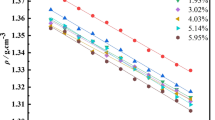Abstract
The methods of 1H NMR and pulsed field gradient NMR are used to study the protic solid electrolyte of calix[4]arene-para-sulfonic acid in the temperature range of –15 to 24°C and water content λ of 1.6 to 5.7 H2O molecules per SO3H. Analysis of the 1H signal intensity in NMR spectra showed that no ice phase is formed in the whole studied temperature and water content range. The hydration numbers of H+(H2O)h complexes are calculated on the basis of the temperature dependences of chemical shift values. The pulsed field gradient NMR technique is used to determine self-diffusion coefficients. Activation energies Eact are calculated on the basis of the temperature dependences of self-diffusion coefficients. Good agreement of the data on diffusion Eact and protic conductivity are shown. A corollary of the Nernst–Einstein equation is used to calculate the values of protic conductivity on the basis of self-diffusion data. The calculated values of protic conductivity in the water content λ range of 1.6 to 5.7 agree with the data obtained experimentally.







Similar content being viewed by others
REFERENCES
Pisareva, A.V., Pisarev, R.V., Karelin, A.I., Shmygleva, L.V., Antipin, I.S., Konovalov, A.I., Solovieva, S.E., Dobrovolsky, Y.A., and Aldoshin, S.M., Proton conductivity of calix[n]arene-para-sulfonic acids (n = 4, 8), Russ. Chem. Bull., 2012, vol. 61, p. 1892.
Shmygleva, L.V., Pisareva, A.V., Pisarev, R.V., Ukshe, A.E., and Dobrovol’skii Y.A., Proton conductivity of calix[4]arene-para-sulfonic acids, Russ. J. Electrochem., 2013, vol. 49, p. 801.
Shmygleva, L.V., Sanginov, E.A., Kayumov, R.R., Ukshe, A.E., and Dobrovol’skii, Y.A., Effect of the structure of calix[4]arene-para-sulfonic acid on its transport properties, Russ. J. Electrochem., 2015, vol. 51, p. 468.
Shmygleva, L.V., Sanginov, E.A., Slesarenko, N.A., Chernyak, A.V., Karelin, A.I., and Dobrovolsky, Y.A., Aspects of proton transport in calix[6]arene sulfonic acid, Ionics, 2017, vol. 23, p. 1793.
Shmygleva, L.V., Slesarenko, N.A., Chernyak, A.V., Sanginov, E.A., Karelin, A.I., Pisareva, A.V., Pisarev, R.V., and Dobrovolsky, Y.A., Effect of Calixarene Sulfonic Acids Hydration on Their Proton Transport Properties, Int. J. Electrochem. Sci., 2017, vol. 12, p. 4056.
Atwood, J.L., Hamada, F., Robinson, K.D., Orr, G.W., and Vincent, R.L., X-ray diffraction evidence for aromatic π hydrogen bonding to water, Nature, 1991, vol. 349, p. 683.
Coleman, A.W., Bott, S.G., Morley, S.D., Means, C.M., Robinson, K.D., Zhang, H., and Atwood, J.L., Novel Layer Structure of Sodium Calix[4]arenesulfonate Complexes—a Class of Organic Clay Mimics?, Angew. Chem. Int. Ed. Engl., 1988, vol. 10, p. 1361.
Dalgarno, S.J. and Raston, C.L., Rapid capture of 4,13-diaza-18-crown-6 molecules by p-sulfonatocalix[4]arene in the presence of trivalent lanthanide ions, Dalton Trans., 2003, no. 3, p. 287.
Martin, A.D. and Raston, C.L., Multifunctional pрphosphonated calixarenes, Chem. Commun., 2011, vol. 47, p. 9764.
Dalgarno, S.J., Atwood, J.L., and Raston, C.L., Structural Versatility in Praseodymium Complexes of p-Sulfonatocalix[4]arene, Cryst. Growth Des., 2007, vol. 7, no. 9, p. 1762.
Tauran, Y., Brioude, A., Shahgaldian, P., Cumbo, A., Kim, B., Perret, F., Coleman, A.W., and Montasserf, I., Calix-arene silver nanoparticles interactions with surfactants are charge, size and critical micellar concentration dependent, Chem. Commun., 2012, vol. 48, p. 9483.
Scharff, J.-P. and Mahjoubi, M., Synthesis and acid-base properties of calix[4], calix[6] and calix[8]arene p‑Sulfonic Acids, New. J. Chem., 1991, vol. 15, p. 883.
Suh, K.J., Hong, Y.S., Skirda, V.D., Volkov, V.I., Lee, C.Y.J., and Lee, C.H., Water self-diffusion behavior in yeast cells studied by pulsed field gradient NMR. Biophys. Chem., 2003, vol. 104, p. 121.
Maklakov, A.I., Skirda, V.D., and Fatkullin, N.F., Self-Diffusion in Polymer Solutions and Melts. (in Russian), Kazan: State University Press. Kazan, 1987.
Volkov, V.I., Korotchkova, S.A., Ohya, H., and Guo Q., Self-diffusion of water-ethanol mixtures in polyacrylic acid-polysulfone composite membranes obtained by pulsed-field gradient nuclear magnetic resonance spectroscopy, J. Membr Sci., 1995, vol. 100, p. 273.
Creekmore, R.W. and Reilley, C.N., Nuclear magnetic resonance determination of hydration numbers of electrolytes in concentrated aqueous solutions, J. Phys. Chem., 1969, vol. 73, p. 1564.
Malinowski, E.R., Knapp, P.S., and Feuer, B., NMR studies of aqueous electrolyte solutions. I. Hydration number of NaCI determined from temperature effects on proton shift, J. Chem. Phys., 1966, vol. 45, p. 4276.
Hucishvili, V.G., Bogachev, Yu.S., and Volkov, V.I., The study of the state of water in the phase of sulphocathionite KU-2 by the method of proton magnetic resonance, Zh. Fiz. Khim., 1983, vol. 57, no. 10, p. 2524.
Author information
Authors and Affiliations
Corresponding authors
Additional information
Translated by M. Ehrenburg
Based on the paper presented at the XIV Meeting “Fundamental Problems of Solid State Ionics,” Chernogolovka (Russia), September 9–13, 2018.
Rights and permissions
About this article
Cite this article
Chernyak, A.V., Slesarenko, N.A. Effect of Temperature and Water Content on the Properties of Solid Protic Electrolyte of Tetra Calixarene Sulfonic Acid: NMR Study. Russ J Electrochem 55, 537–543 (2019). https://doi.org/10.1134/S1023193519060077
Received:
Revised:
Accepted:
Published:
Issue Date:
DOI: https://doi.org/10.1134/S1023193519060077




